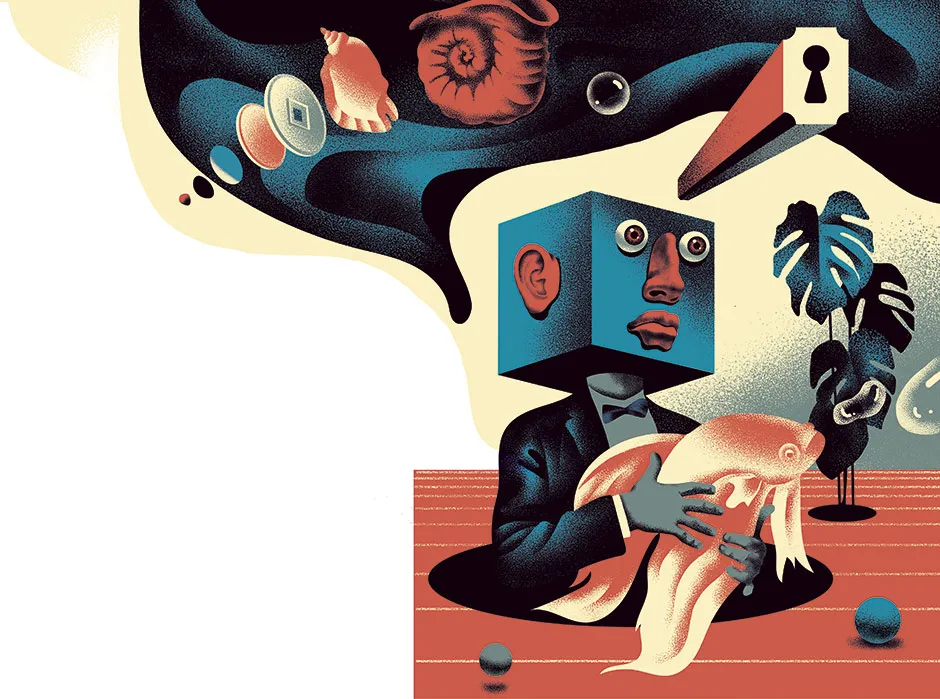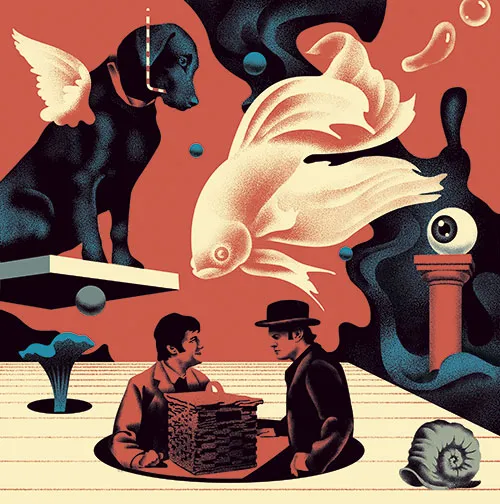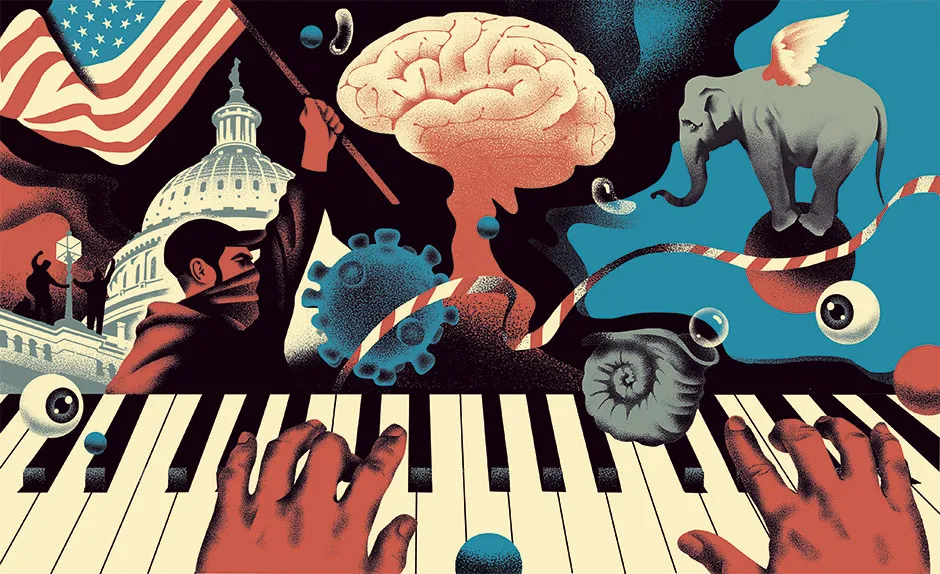There is a classic Monty Python sketch in which a customer, played by John Cleese, enters a pet shop to buy a cat. The dodgy shopkeeper, played by Michael Palin, whips out a terrier instead and offers to convert the dog surgically into a cat, a budgie, or a fish.
“Terriers make lovely fish,” he assures the customer. “I could do that for you straight away. Legs off, fins on, stick a little pipe through the back of its neck so it can breathe, bit of gold paint…” In real life, we often view our pets in terms of other animals, and no scalpel is required.
Perhaps you’ve met dogs who are so aloof that they seem like cats, or cats who are so affiliative that they’re more like dogs. My family used to have a pet betta fish named Ariel who seemed more puppy than fish. She’d allow us to pet her without complaint, and when we dropped food in the fish tank she’d nuzzle our fingers.
This topic might seem frivolous, but it reveals a superpower of the human brain. We can consider a physical object, such as a fish, and impose new functions on it that are not part of its physical nature, using only our collective minds. To my family, Ariel was a puppy, even though nothing about her body was dog-like.
We simply agreed that Ariel had puppyish qualities, and that agreement became our reality. (The perceptive reader may have noticed that I’ve referred to Ariel as ‘she’, even though the colourful bettas sold in pet shops are always male. Our daughter, who was three at the time and in love with Walt Disney’s The Little Mermaid, informed us in no uncertain terms of Ariel’s preferred pronoun.)
Read more about the brain:
- Sleep in quarantine: Is the lockdown affecting our dreams?
- How to maximise your motivation, according to a neuroscientist
This superpower to modify physical reality is called ‘social reality’. You or I can simply make something up and communicate it to other people, and if they treat it as real, it becomes real. For better or for worse.
Social reality has an astonishing level of influence on our lives. We impose functions on bits of paper and metal and they become money. We draw imaginary lines in the dirt and they become the borders of a country, and the people on opposite sides of those imagined lines transform into citizens with rights, and foreigners without them.
Brexit is also social reality. Even your own name is social reality. Someone just made it up, and you and other people treat it as real. In fact, most of us spend most of our time in a real world of serious make-believe.
How your brain deals with sensory information
How do human brains create social reality? To answer this, let’s consider it from a brain’s point of view. For your whole life, your brain is trapped inside a dark, silent box called your skull.
Your brain constantly receives data from your eyes, ears, nose, and other sense organs. It also receives a continuous stream of sense data from inside your body as your lungs expand, your heart beats, your temperature changes, and the rest of your insides carry on their symphony of activity.
All this data presents a mystery to your brain-in-a-box. Together, the data represents the end result of some set of causes that are unknown.
When something in the world produces a change in air pressure that you hear as a loud bang, some potential causes could be a door slamming, a gunshot, or a fish tank toppling to the floor. When your stomach unleashes a gurgle, the cause might be hunger, indigestion, nervousness, or love.

So, your brain has a problem to solve, which philosophers call a ‘reverse inference problem’. Faced with ambiguous data, your brain must somehow guess the causes of that data as it plans what to do next, so it can keep you alive and well.
Fortunately, your brain has another source of information that can help with this task: memory. Your brain can draw on your lifetime of past experiences, some of which were similar to the present moment, to guess the meaning of the sense data.
A slammed door, rather than a fish tank, may well be the best candidate for a loud bang if, for example, there is a strong breeze blowing through a nearby window, or if your heartbroken lover has just stormed out of the room and you’ve experienced similar exits in past relationships.
Your brain’s best guess – right or wrong – manifests itself as your action and everything you see, hear, smell, taste and feel in that moment. And this whirlwind of mental construction all happens in the blink of an eye, completely outside of your awareness.
The esteemed neuroscientist Gerald Edelman described daily experience as “the remembered present”. You might feel like you simply react to events that happen around you, but in fact, your brain constantly and invisibly guesses what to do next and what you will experience next, based on memories that are similar to the present moment.
A key word here is ‘similar’. The brain doesn’t need an exact match. If you saw Ariel the betta for the first time, your brain could guess that she’s a fish because you’ve seen similar fish before in bowls. Likewise, you have no trouble climbing a new, unfamiliar staircase because you’ve climbed staircases in the past. So similarity is enough for your brain to help you survive and thrive in the world.
Read more about how the brain works:
- The mirror neuron: How imitating our role models shapes our brains
- This is your brain on love: the beautiful neuroscience behind all romance
In psychology and philosophy, things that are similar to one another form a category. For example, think about fish, a common-sense category that includes many taxonomic groups of aquatic animals. Fish come in all colours, shapes and sizes. They swim with a variety of motions. Some travel in schools and others are solitary. Some live in oceans, some in ponds, and some in human homes.
A typical fish may have fins and scales and breathe underwater, but some fish have no scales (such as sharks), some have no fins (such as the hagfish), and a few can breathe on land (such as the lungfish). Despite this, we still consider all of these creatures similar and call them fish. We would never consider a dog to be a fish (Michael Palin’s creation notwithstanding).
You might think that categories exist in the outside world, but in fact, your brain makes them. If I ask you to imagine a fish as a pet, your brain creates a category that could include bettas, goldfish and guppies. But if I ask you to imagine a fish in a restaurant, your brain would more likely build a category from cod, haddock and salmon. So a category like ‘fish’ is not something static in your brain. It is an abstract category that your brain creates, based on context.
The most important similarities forming a category like ‘fish’ are not about physical looks but about function. You don’t eat a betta sandwich for lunch or keep a salmon in an aquarium, because the function of a pet is different from the function of a meal.
Similarly, the function of a fishbowl is usually to hold live fish, but in another context it can become a vase for flowers, a container for pencils or spare change, a drinking bowl for a thirsty dog, a fire extinguisher for a small blaze, or even a weapon to hurl at an attacker.
How social reality creates physical reality
Abstract categories are tremendously flexible. Consider the following three objects: a bottle of water, an elephant and a pistol. These objects do not look alike, feel alike, smell alike, or have any other obvious physical similarities. It turns out that they do share a physical function: they can all squirt water. So they form a category.
But they also share another function that, unlike water-squirting, is completely untethered from their physical nature. They are members of the category, ‘things that would fail to pass through airport security’. This purely abstract category is only based on function and is a product of human minds (other members of this category include cocaine, the Sahara Desert, and loud, rude songs about immigration officials).
Purely abstract categories, in fact, drive many of your actions and experiences. When your brain makes guesses about the sense data around and within you, those guesses often form an abstract category based on function.
To explain a feeling of shortness of breath, your brain might construct a category containing physical exercise, a punch in the gut, surprise, lust and a hundred other potential causes that are all similar to the present moment, so it can whittle them down and act. Category construction is the process by which your brain figures out what something is, what to do about it, and how it should regulate your organs, hormones and immune system as it prepares for action.

Abstract categories are also the engine behind social reality. When we impose a function on an object, we categorise that object as something else. Throughout our history, all manner of objects have belonged to the abstract category ‘money’: not only paper rectangles and metal discs, but also shells, barley, salt, and carved boulders too heavy to move. We even impose the functions of money on intangibles such as mortgages and Bitcoin.
We share such categorisations and make them real – sometimes with only a small group, like my family did with Ariel the fish-puppy, and sometimes with a large population, as with money and countries and citizenship.
Social reality is so powerful that it even influences our genetic evolution as a species. Money, for example, is entirely made-up, but it’s so real to us that people who have more money live longer. They can eat healthier foods, live more comfortably, and obtain better medical care. These factors influence who is available and healthy enough to reproduce, and how likely it is for their offspring to survive and thrive.
As another example, various cultures in history have established laws or norms for who may reproduce with whom. Some rules prohibit sex between people of different skin tones, such as the segregation laws in the United States during times of slavery. Others limit childbirth, such as China’s former one-child policy which, in a culture that values sons over daughters, led to more male offspring than female and ultimately to millions of Chinese men who cannot marry Chinese women.
Read more about the senses:
- Can your train your ears to hear better?
- Where does our sense of direction come from within the brain?
Social reality can even shape physical reality. For example, it’s a stereotype to think that girls aren’t good at maths. When people believe the stereotype, which is social reality, they may expose girls to fewer maths and physics problems than they do boys, creating a self-fulfilling prophecy that perpetuates the stereotype and wastes the potential of half the population.
A more pernicious example is childhood poverty. Research shows that early and long exposure to poverty is harmful to developing brains and may lead to poorer performance in school. Less education increases children’s risk of living in poverty when they grow up and have children of their own. Through a vicious cycle, society’s stereotypes about poverty, which are social reality, can become the physical reality of brain wiring.
Social reality is normally constrained by physical reality. We could all agree that we can fly through the air by flapping our arms, or that it’s healthy to eat glass. But mere agreement won’t change the physical nature of things and make these ridiculous ideas true.
Nevertheless, social reality can become completely untethered from physical reality, as we are seeing today. Viruses like COVID-19 are physically real. They don’t care about human categories; all they require is a nice, wet pair of lungs to occupy. And yet, in the current pandemic, despite abundant physical evidence, many people still believe and behave like the deadly virus is not a serious problem, leading to further spread.

This potential for untethering leaves social reality fragile and vulnerable to manipulation. Consider democracy, which is social reality on a large scale. The act of voting for a leader, by making and tallying little marks on paper, is meaningful only because we give it meaning and agree on that meaning.
Now witness what happened when a US president claimed to have won an election that he verifiably lost by a large margin of little marks. Millions of citizens believed his story anyway, thereby creating an alternative social reality, and a crowd of them broke into a government building in protest, stole and destroyed property, and even caused death.
The building in question wasn’t just any government building, but one that holds a sacred meaning in a social reality shared by both sides: the US Capitol, home of the United States Congress. The same superpower that gives us achievements like democracy, can also destroy those achievements.
The human brain is one of the most incredible 1.5kg blobs of jiggly meat that evolution ever produced. In every moment, through electricity and swirling chemicals, your brain somehow conjures up the past to predict the future, to control your body and create your experience in the present.
An ensemble of human brains together create social reality, a superpower that can turn fish into puppies, boulders into currency, stereotypes into brain wiring, and a person into a president. Any group of people can make up abstract concepts, share them, and weave them into a reality. Consequently, we have more control over reality than we might think, and more responsibility for reality than we might realise or want.
- This article first appeared inissue 360ofBBC Science Focus Magazine–find out how to subscribe here
Seven and a Half Lessons About the Brainby Lisa Feldman Barrett is out now (£14.99, Picador).
- Buy now from Amazon UK, Bookshop.org or Waterstones
- This is one of our top science books for March 2021